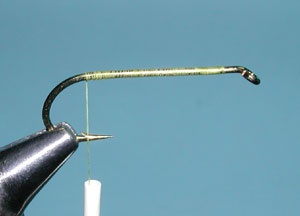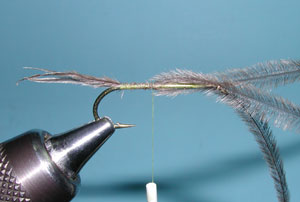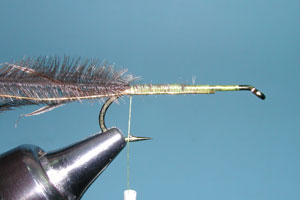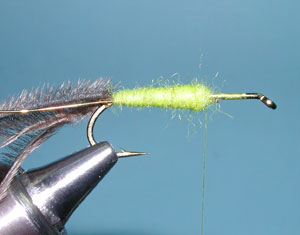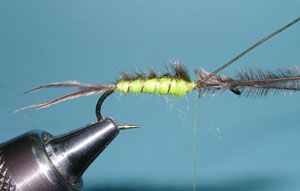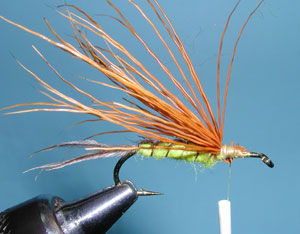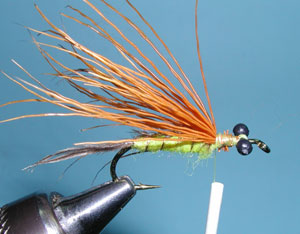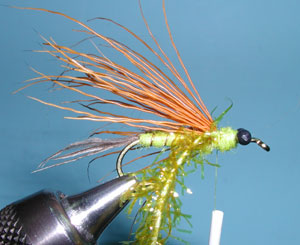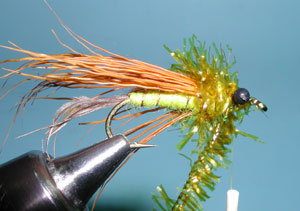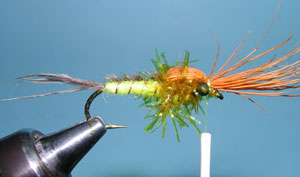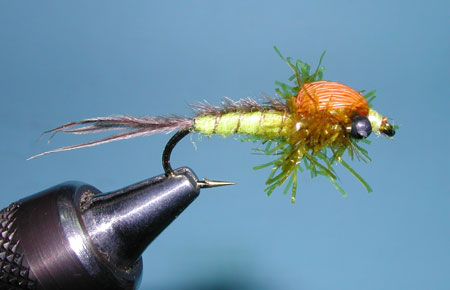Gray’s Hex Nymph – awesome in a late afternoon opportunity
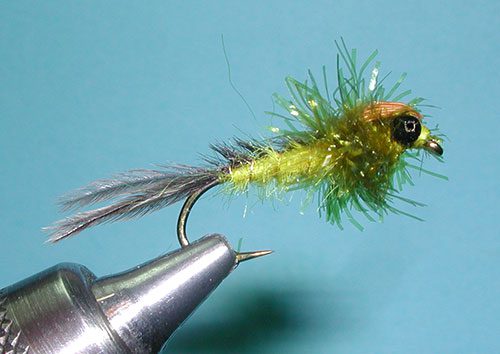
Gray’s Hex Nymph
Tying Instructions
| Materials
to Order Material, click the link |
|
|---|---|
| Hook | Daiichi 1710 #6-10 |
| Thread | Danville Pale Yellow 6/0 |
| Eyes | Small Black Bead Chain Eyes |
| Body | Yellow Angora Goat |
| Thorax | Olive Medium Krystal flash Chenille (Back) and Olive Micro Polar Chenille (Front) |
| Tail and Crackback | Gray Ostrich Herls |
| Wingcase | Golden Brown Deer hair |
| Ribbing | Medium Gold Wire |
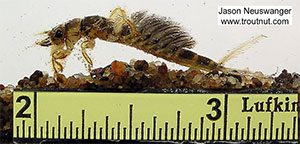
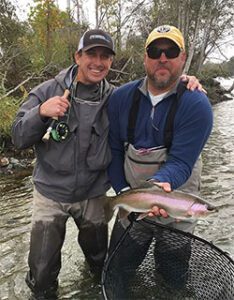
Lincoln Gray
Gray’s Hex Nymph
Hexagenia nymphs burrow into the silty bottom of some lakes and slow-moving rivers. They are rarely available to trout until they start to hatch. The hex hatch starts after sunset, but a few hours before the duns start appearing on the surface, the nymphs become active and are sometimes taken by trout.
An Evening Hatch
A couple of hours before sunset, drop this fly near the bottom with a fast sinking line to get the Hex nymph deep and use a lift and drop retrieve. Once the hatch is underway, try retrieving the nymph quickly to the surface with a vertical retrieve. Near sunset, switch to a floating line using the nymph pattern and the paranymph.
Gray’s Hex Nymph
Gray’s Hex Nymph is designed by Lincoln Gray, Sales Manager of Sierra Stream and Mountain in Chico, CA . This pattern was featured in the Summer 2008 Fly Tyer Magazine. Lincoln operates a stillwater flyfishing school on Lake Almanor and has been developing a series of hex patterns based upon his 30 years of fishing this lake. This pattern imitates the nymph of a Hexagenia mayfly (big yellow may). These nymphs have large gills along the abdomen, represented by the Ostrich Herl on the top of the abdomen of Lincoln’s pattern.
Gray’s Hex Nymph is also used in tandem with Gray’s TS Bugger. The Bugger pattern is positioned about 12-15 inches behind the nymph and stripped slowly with a sinking or intermediate line. Most of Lincoln’s patterns have been a collaborative effort between Lincoln and his twin brother, Lance. Lance is a fishing guide (lancegrayandcompany.com) out of Willows, CA and has a number of hex patterns on his website as well as those tied by other Almanor guides, such as Milt Jensen.
Aftershaft feathers
Note that Lance is using the aftershaft feathers from a Ginger Rooster Saddle for the gills. The aftershaft feather is underneath just about every body feather, it is a downy, usually grayish and very soft feather. The feather provides additional insulation to the bird and has a marabou or CDC type of structure. An aftershaft feather has a rather weak stem and must be anchored to the top of the abdomen with wire ribbing.
Other Variations
The late Michael Fong wrote a nice article for “Fly Fisherman Magazine” entitled, “Western Hex Fishing”. I believe it was in the mid-Nineties. He highlighted fishing Lake Almanor with Guide Milt Jensen who created Milt’s Hex Nymph. His recipe called for a ribbing of “36 Gauge brass beading wire” and using a wrapped Ginger or Brown Saddle Hackle for the legs. He mentioned that Milt preferred Furnace Saddle Butts for the gills and natural brown saddle fibers for the tail.
Michael also called for an epoxy finish to be applied to the wing case and head carapace for a glossy appearance. Michael indicated that this fly could be fished in open water for the trout but that smallmouth bass would like to hit this fly around structure. Milt also designed his Hex paranymph pattern for a crippled nymph at the surface. This pattern is excellent just at the time of the hatch using a floating line.
Variations
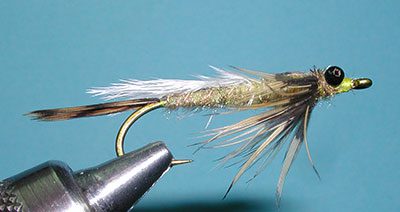
Lance’s Hex Nymph
| Hook | TMC 9395 size 6-8 |
| Thread | Danville Pale Yellow 6/0 |
| Eyes | Small Black Bead Chain Eyes |
| Weight | 0.25 Leadfree wire (8-12 wraps) |
| Body | Antron Dubbing, Hexagenia |
| Thorax | Antron Dubbing, Hexagenia |
| Tail | Pheasant Tail dyed Olive |
| Gills | Natural Ginger Aftershaft (from a Ginger Tailing Hackle) |
| Wingcase | Mottled Oak Turkey |
| Ribbing | Medium Gold Wire |
| Legs | Pheasant body feather |
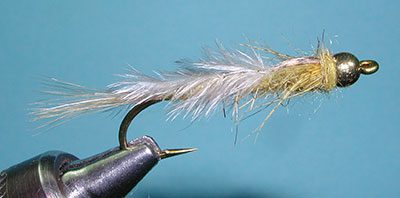
Milt’s Hex Nymph
| Hook | TMC 9395 size 6-8 |
| Thread | Danville Pale Yellow 6/0 |
| Head | 5/32 Tungsten Bead |
| Body | Golden Stone Haretron |
| Thorax | Golden Stone Haretron |
| Tail | Light Pardo Tailing Fibers |
| Gills | Natural Gray Aftershaft (from a Light Pardo Tailing Hackle) |
| Wingcase | Mottled Oak Turkey |
| Ribbing | Medium Copper Wire |
| Legs | Mallard Flank dyed Woodduck |
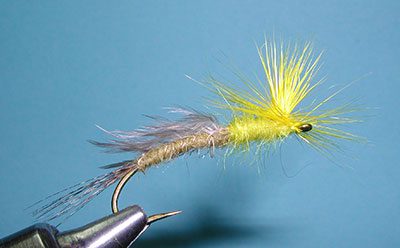
Milt’s Hex Paranymph
| Hook | Tiemco 200R #6 |
| Thread | Danville Pale Yellow 6/0 |
| Body | Golden Stone Haretron |
| Thorax | Angora Goat, Yellow |
| Tail | Dark Pardo Tailing Fibers |
| Gills | Natural Gray Aftershaft (from a Dark Pardo Tailing Hackle) |
| Wingcase | Yellow dyed Deer Belly Hair |
| Ribbing | Medium Copper Wire |
| Hackle | Yellow Saddle Hackle |

